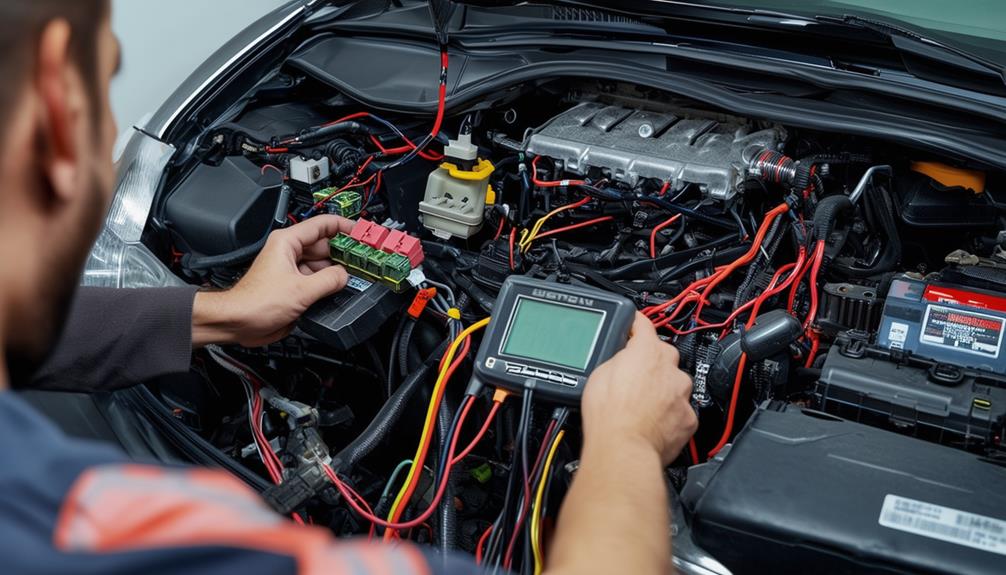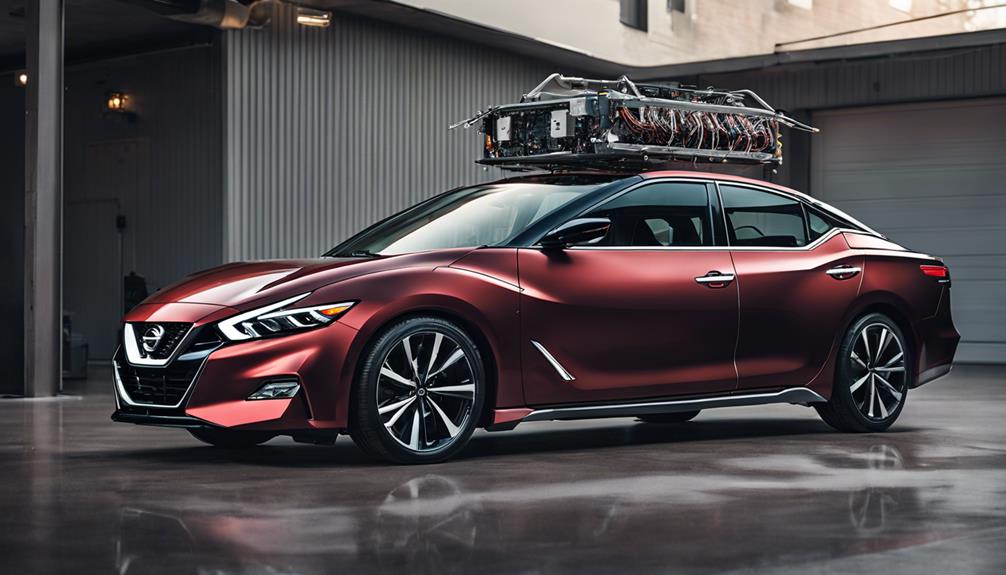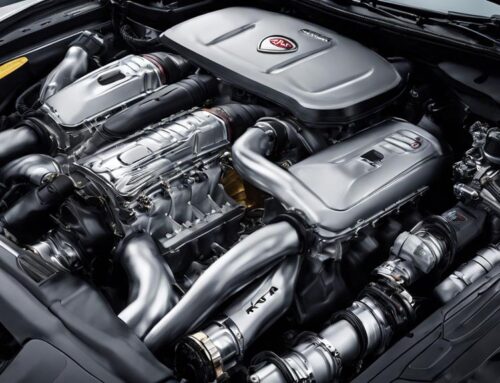Your Nissan Maxima's electrical system integrates essential components like the alternator, Power Distribution Module (PDM), and uniquely synchronized key fobs for maximum efficiency and security. The alternator maintains electrical balance, while the PDM distributes power efficiently. Important systems such as remote start and smart keys enhance utility and security. Regular battery maintenance and voltage checks are necessary for sustaining system efficiency. Fuse boxes prevent overloads and short circuits and should be routinely inspected. If you're interested in upgrading, consider enhanced alternators and LED lighting. Stay tuned to learn about diagnosing key system failures and more advanced insights.
Key Takeaways
- The alternator maintains electrical balance and keeps the battery charged.
- The Key System features uniquely synchronized key fobs and remote start capability.
- Fuse boxes protect the electrical system from overloads and short circuits.
- Regular battery maintenance includes inspecting electrolyte levels and ensuring proper voltage.
- Wiring diagrams map out every circuit connection, aiding in efficient troubleshooting.
Electrical Components in Maxima

Starting with the electrical components in the Nissan Maxima, you'll find that this vehicle is equipped with a sophisticated array of systems designed to enhance performance and user experience. At the core of these systems is the alternator, whose function is crucial in maintaining the vehicle's electrical balance. The alternator converts mechanical energy into electrical energy, guaranteeing that the battery remains charged and that all electronic components receive the necessary power. This also supports the advanced key systems, such as smart keys and push-button start, which are vital to the Maxima's modern features.
Power distribution in the Maxima is meticulously engineered for maximum efficiency. The Power Distribution Module (PDM) oversees the allocation of electrical energy throughout the vehicle. This module ensures that critical systems such as ignition, lights, and Advanced Driver Assistance Systems (ADAS) receive priority power, while also managing secondary systems like infotainment and climate control. By doing so, the PDM maintains peak performance even under varying load conditions.
In the Maxima, the integration of smart sensors and microcontrollers further refines power distribution. These components monitor real-time data and adapt the power flow to accommodate immediate demands.
For example, when the vehicle's high-demand features like adaptive cruise control or collision avoidance systems are engaged, the PDM reallocates power to these functions seamlessly, preventing any drop in performance or efficiency.
Additionally, the Maxima's electrical components are interconnected via a CAN bus network. This system facilitates rapid communication between electronic control units (ECUs), guaranteeing that any change in one system is instantly relayed and compensated for across the vehicle's architecture. This advanced level of integration and control underscores Nissan's dedication to innovation and reliability, delivering a driving experience that's both dynamic and trustworthy.
Key System Integration
Nissan Maxima's key system integration exemplifies advanced automotive technology, blending convenience with security seamlessly. You're in for a treat with this sophisticated setup that sets your Maxima apart in terms of both functionality and innovation. The system is designed to work effortlessly with the vehicle's electrical architecture, enhancing both safety and usability.
Key programming is at the heart of this system, ensuring that each key fob is uniquely synchronized with your Maxima. This precise synchronization process involves encoding a unique identifier within the key fob and the vehicle's ECM (Engine Control Module), providing a robust layer of security. You can appreciate the meticulous engineering that goes into guaranteeing that only authorized keys can start your vehicle, minimizing the risk of unauthorized access.
Key programming is a critical feature, especially when you need to replace or add a new key fob. The process is straightforward yet secure, protecting against unauthorized duplications.
Remote start functionality takes the convenience factor to another level. Imagine being able to start your Maxima from the comfort of your home or office. With the push of a button on your key fob, the vehicle's engine roars to life, allowing the cabin to reach a comfortable temperature before you even step inside. This feature is particularly beneficial in extreme weather conditions, providing both comfort and efficiency.
Here's a quick rundown of the key features that make this system exceptional:
- Advanced Key Programming: Each key fob is uniquely programmed to communicate with your vehicle's ECM, ensuring high-level security.
- Remote Start Capability: Start your vehicle remotely to pre-condition the cabin, enhancing comfort and convenience.
- Seamless Integration: The system works flawlessly with other electronic components, offering a cohesive and reliable user experience.
Troubleshooting Electrical Issues

When tackling electrical issues in your Nissan Maxima, understanding the vehicle's intricate electrical system is essential. The Maxima's electrical architecture is sophisticated, incorporating multiple control modules, sensors, and actuators. To begin troubleshooting, you need to approach the problem systematically.
First, assess any voltage fluctuations. Inconsistent voltage can wreak havoc on the Maxima's sensitive electronics. Use a digital multimeter to measure the voltage at various points in the system. Check the battery terminals, alternator output, and main fuses. Verify that the readings are within the manufacturer's specified range. Voltage fluctuations might indicate a failing alternator, deteriorated wiring, or corroded connections. For more insights on common electrical problems, refer to the Ultimate Troubleshooting Guide for Nissan Maxima Owners.
Next, examine grounding issues. Grounding points are critical for the proper functioning of the vehicle's electrical components. Poor grounds can lead to erratic behavior in systems such as the infotainment unit, lighting, and engine control modules.
Inspect all major grounding straps and connections for signs of corrosion or looseness. Clean and tighten any compromised grounds to establish a solid connection.
You should also scan the vehicle's On-Board Diagnostic (OBD) system. The OBD-II port can provide valuable Diagnostic Trouble Codes (DTCs) that pinpoint faulty sensors or modules. Utilize a professional-grade OBD scanner to retrieve and interpret these codes, which can guide you to the exact location of the issue.
Battery Management
A well-maintained battery is vital for your Maxima's electrical system, guaranteeing consistent performance and longevity. To achieve peak battery management, you need to focus on key aspects such as battery maintenance and power distribution, ensuring each component operates at top efficiency. Regular maintenance is essential, as highlighted in the Essential Maintenance Guide, which underscores the importance of keeping your vehicle's electrical systems in prime condition.
First, let's talk about battery maintenance. Regular inspection and cleaning of your battery terminals can prevent corrosion build-up, which can hinder power distribution. Make sure that the battery is securely fastened in its housing to avoid vibrations that could harm internal components. Monitoring the battery's electrolyte levels and replenishing them with distilled water when necessary will also extend its lifespan.
To keep your Maxima's power distribution system running smoothly, you should:
- Perform periodic voltage checks: Use a multimeter to verify the battery voltage is within the best range of 12.4 to 12.7 volts when the engine is off. This ensures the battery holds a proper charge.
- Test load capacity: Employ a battery load tester to simulate real-world conditions, confirming the battery can deliver sufficient power under load. This step is essential to identify potential failures before they occur.
- Inspect the alternator: A malfunctioning alternator can lead to insufficient charging of the battery. Verify the alternator's output is within the manufacturer's specifications to maintain a strong power distribution network.
Fuse Box Overview

Located within the engine bay, the fuse box is a critical component of your Maxima's electrical system, acting as the central hub for circuit protection. Understanding its precise location and function will empower you to address electrical issues efficiently. For more details on potential safety concerns, you can review recalls and safety issues to guarantee your Maxima remains in top condition. Positioned near the battery, the fuse box location ensures easy access for diagnostics and maintenance.
Your Maxima's fuse box contains a series of fuses that protect various electrical circuits from overload. Each fuse corresponds to a specific component or system, such as the headlights, power windows, or audio system. The fuse box is designed with a cover that often includes a diagram, detailing which fuse controls each circuit. This layout simplifies troubleshooting and fuse replacement, making it a straightforward process even for those new to automotive maintenance.
When performing a fuse replacement, first, identify the faulty fuse by checking for a break in the metal filament or using a multimeter for a more precise diagnosis. Always replace it with a fuse of the same amperage rating to prevent potential damage to the electrical system. Using a higher or lower-rated fuse can lead to either insufficient protection or an inability to handle the required electrical load, respectively.
The advanced design of the Maxima's fuse box incorporates blade fuses, known for their reliability and ease of replacement. These fuses are color-coded by amperage, which aids in quick identification and reduces errors during replacement. For those seeking innovation, integrating smart fuses that provide real-time status updates could be a future upgrade, enhancing your vehicle's diagnostic capabilities.
Wiring Diagram Basics
Understanding the wiring diagram basics is necessary for diagnosing electrical issues in your Nissan Maxima. To navigate the intricate web of wires under the hood, you need to grasp how circuit connections and voltage regulation work in harmony. Let's delve into the fundamentals that will make you proficient in interpreting these diagrams. It's also important to note that regular upkeep plays an important role in preventing electrical issues.
First, recognize that wiring diagrams are essentially blueprints for your vehicle's electrical system. They map out every circuit connection, showing how components like sensors, relays, and switches interact. These diagrams use standardized symbols to represent different electrical elements, ensuring you can decode them efficiently.
Here are three key aspects to focus on:
- Wire Colors and Codes: Different colors and codes represent various wires, indicating their function and destination. For example, a red wire might signify a power supply, while a black wire could indicate a ground connection.
- Voltage Regulation Paths: Understanding how voltage regulation paths are laid out in the diagram is important. This helps you identify areas where voltage might drop or spike, which can lead to performance issues or component failures.
- Grounding Points: Identifying all grounding points in the diagram is crucial. Proper grounding ensures that the electrical system operates correctly and safely, preventing potential short circuits or erratic behavior.
When you interpret a wiring diagram, start by identifying the power source and follow the flow towards each component. This methodical approach helps you pinpoint issues like broken circuit connections or faulty voltage regulation, empowering you to troubleshoot effectively. By mastering these basics, you'll be well-equipped to tackle any electrical challenge your Nissan Maxima might present, making your vehicle more reliable and innovative.
Common Electrical Problems

When diagnosing your Nissan Maxima's electrical system, you'll often encounter common electrical problems that can hinder performance and safety. Understanding these issues can't only streamline troubleshooting but also enhance your vehicle's dependability. In some cases, you may need professional help, such as emergency lockout assistance, which can be essential in resolving unexpected issues.
One prevalent issue is alternator failure. The alternator is vital for maintaining electrical power and recharging the battery. Symptoms of alternator issues include dimming headlights, electrical accessories malfunctioning, and the battery warning light illuminating on your dashboard. A failing alternator can lead to a drained battery, leaving you stranded. To diagnose, measure the voltage output; it should be between 13.5 to 14.5 volts with the engine running. If the voltage is outside this range, replacing or repairing the alternator is necessary.
Another frequent problem involves power window issues. These can stem from faulty window regulators, worn-out motors, or electrical circuit failures. If your power windows are sluggish or non-responsive, start by checking the fuse box for any blown fuses associated with the power windows. Next, inspect the window switch and motor, as these components are prone to wear. Utilize a multimeter to verify continuity and optimize the motor receives adequate voltage. Replacing defective parts can restore proper window function.
Both alternator failure and power window issues require prompt attention to maintain your Maxima's performance and safety. By addressing these common problems with technical precision and detailed analysis, you optimize that your vehicle remains in peak condition.
Whether you're a seasoned mechanic or an innovative car enthusiast, staying ahead of these electrical challenges is key to maintaining your Nissan Maxima's dependability and efficiency.
Ignition System Overview
The ignition system in your Nissan Maxima plays a pivotal role in starting the engine and ensuring peak performance. The system encompasses several critical components that work harmoniously to ignite the air-fuel mixture within the engine cylinders. Understanding the intricacies of your ignition system can greatly enhance your vehicle's efficiency and longevity. If you ever face issues with your key, knowing about Nissan key replacements can be extremely helpful.
Firstly, the spark plugs are the cornerstone of the ignition system. They generate the spark needed to ignite the air-fuel mixture, transforming chemical energy into mechanical energy. The health of your spark plugs directly impacts your engine's performance, fuel efficiency, and emissions.
- Ignition Timing: This is the precise moment the spark plug fires within the combustion cycle. Correct ignition timing ensures top engine performance, fuel efficiency, and reduced emissions. Advanced ignition timing can lead to pre-ignition or knocking, while delayed timing can result in poor fuel economy and sluggish performance.
- Ignition Coil: This component transforms the battery's low voltage to the thousands of volts needed to create the spark. A malfunctioning ignition coil can lead to misfires, rough idling, and overall subpar engine performance.
- Crankshaft Position Sensor: This sensor monitors the position and rotational speed of the crankshaft, relaying critical data to the engine control unit (ECU) to adjust ignition timing accordingly. Accurate data from the crankshaft position sensor ensures smooth engine operation and top ignition timing.
Diagnosing Key System Failures

Having grasped the importance of the ignition system, let's move on to diagnosing key system failures in your Nissan Maxima. To achieve pinpoint accuracy, start with voltage testing. Utilize a multimeter to measure voltage at various points in the electrical circuit. Confirm the battery's voltage reads around 12.6 volts when fully charged. A lower reading signifies potential battery issues rather than a faulty key system.
Next, focus on circuit analysis. Examine the continuity of the wiring harness connecting the key fob receiver to the ignition system. Discontinuities could indicate broken wires or poor connections. For those unsure about wiring harness continuity, you might want to reference a complete guide on programming as it can provide deeper insights.
Inspect the fuse box for blown fuses linked to the key system circuitry. Replace any compromised fuses.
Another critical step involves testing the key fob's signal strength. Employ a frequency meter to verify the transmission from the key fob. A weak or absent signal could be due to a drained fob battery or a malfunctioning transmitter.
Evaluate the immobilizer system. Modern Nissan Maximas incorporate a transponder chip within the key fob. Use a diagnostic scanner to interface with the vehicle's ECU and verify if the key's code matches the registered codes in the system. Mismatches or error codes can point to ECU or transponder faults.
Lastly, don't overlook the ignition switch itself. Perform resistance testing across the ignition switch terminals. Abnormal resistance values suggest internal wear or damage, compromising the switch's ability to recognize the key.
Upgrading Electrical Components
Upgrading electrical components in your Nissan Maxima can greatly enhance performance and reliability. Whether you're looking to improve efficiency, boost power, or guarantee long-term durability, targeted upgrades can make a significant difference.
Here's an in-depth exploration into performance upgrades and custom installations that can elevate your Maxima to the next level. According to Ultimate Guide to Customizing Your Nissan Maxima, ensuring safety and legal compliance is essential when making any modifications.
First, consider upgrading your alternator. A high-output alternator can supply more consistent and powerful electrical currents, which is essential for performance upgrades such as high-powered audio systems or additional lighting. This guarantees that your battery remains charged and your electrical components operate at their best.
- High-Output Alternator: Provides robust electrical currents for demanding components.
- Performance Batteries: Opt for AGM (Absorbent Glass Mat) or lithium-ion batteries that offer higher reserve capacity and faster charging times.
- Enhanced Grounding Kits: Improve electrical flow and reduce resistance, guaranteeing that all components receive stable voltage.
In addition to these upgrades, custom installations can truly personalize your Maxima. Custom wiring harnesses allow for seamless integration of aftermarket components, reducing the risk of electrical failures.
Furthermore, upgrading to LED lighting systems not only enhances visibility but also reduces power consumption, which is essential for maintaining overall electrical health.
When engaging in these upgrades, it's crucial to ensure compatibility with your Maxima's existing electrical system to prevent overloads or failures. Consulting with a professional who specializes in Nissan Maxima electrical systems can provide you with tailored advice and installation services. By focusing on precision and quality, you'll achieve a more reliable and high-performing vehicle that stands out on the road.
Frequently Asked Questions
How Do I Reset the Nissan Maxima's Onboard Computer?
To reset your Nissan Maxima's onboard computer, follow these troubleshooting steps: Disconnect the negative battery terminal for 15 minutes. This computer reset process clears error codes and reboots system functions, optimizing vehicle performance through innovative diagnostic recalibration.
Can I Install Aftermarket Audio Systems Without Voiding the Warranty?
Yes, you can install aftermarket audio systems without voiding the warranty, provided you follow manufacturer approval guidelines. Guarantee the installation process is meticulous to maintain sound quality and avoid adverse warranty implications. Always prioritize precision and innovation.
What Are the Signs of a Failing Alternator in a Nissan Maxima?
You might notice battery issues and charging problems when diagnosing a failing alternator in your Nissan Maxima. Look for dimming lights, electrical malfunctions, and intermittent power loss. Solutions include testing voltage output and inspecting the drive belt.
How Do I Check for Software Updates for My Maxima's Electrical System?
To check for firmware updates on your Maxima's electrical system, connect diagnostic tools like OBD-II scanners. Use specialized software to access the ECU, ensuring your system's up-to-date and optimized for peak performance and innovation.
Are There Any Common Recalls Related to the Maxima's Electrical System?
To determine common recalls related to the Maxima's electrical system, conduct a recall analysis using manufacturer databases. Focus on electrical upgrades, ensuring your vehicle incorporates the latest innovations and addresses any regulatory compliance issues.
Conclusion
In wrapping up, you've now got a solid grasp of the Nissan Maxima's electrical system. From the intricacies of the key system to troubleshooting common issues, you're equipped to tackle any challenge. Think of this knowledge as your toolkit—each piece crucial for maintaining peak performance. Whether upgrading components or diagnosing failures, your understanding guarantees the Maxima remains a reliable beast on the road. Keep this guide handy; it's your technical compass in the world of automotive electrical systems.









